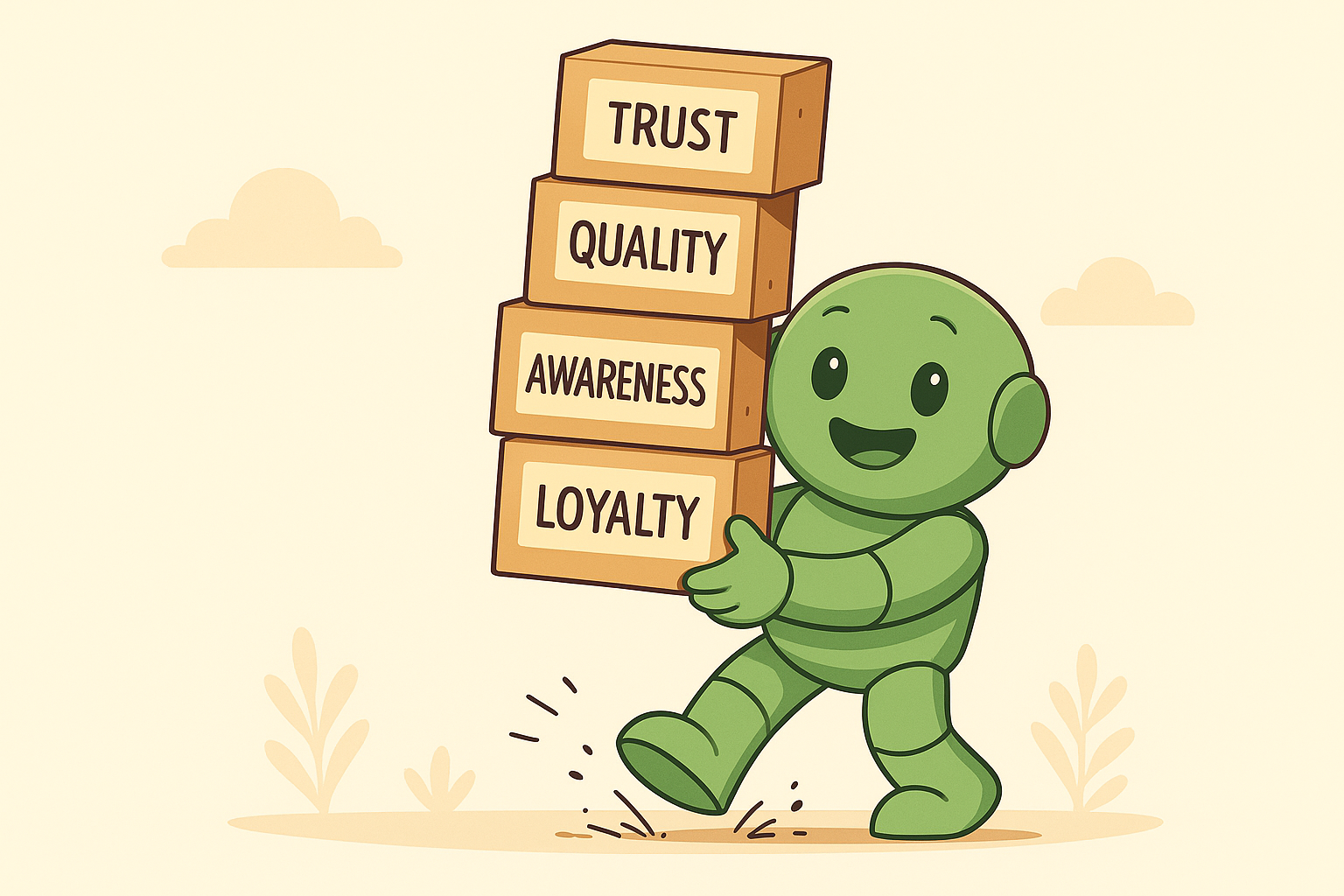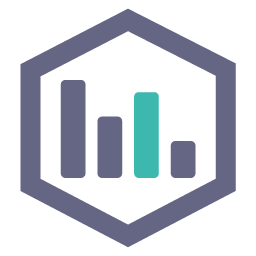How to Measure Brand Equity A Practical Guide
Measuring brand equity is part art, part science. It's about blending the qualitative—the feelings people have about your brand, captured through things like focus groups and sentiment analysis—with the quantitative—the hard numbers from brand awareness surveys and financial reports. When you get this mix right, you can truly understand your brand's value and its influence in the market.
What Is Brand Equity and Why Does It Matter?

Before you can measure it, you have to know what brand equity really is. At its heart, it’s the collective perception customers have about your company. It’s the magic that makes someone choose Nike over a generic sneaker or gladly pay a premium for an Apple device. This isn't something you build overnight; it’s earned through years of consistently delivering on your brand promise.
Think of brand equity as a powerful, intangible asset. It directly impacts how much a customer is willing to pay, how loyal they are, and whether they'll recommend you to others. A strong brand can sail through tough market conditions, command higher prices, and even attract the best talent. When customers trust you, their buying decisions become simpler, which translates into more predictable revenue for your business.
The Pillars of Brand Equity
To get a real handle on brand equity, it helps to break it down. I’ve found it’s most useful to think about it in terms of four foundational pillars: Awareness, Perception, Preference, and Loyalty. Each one builds on the last, creating a strong and resilient brand.
These aren't just abstract ideas; they're the bedrock of your brand's value, both financially and culturally.
The table below breaks down these pillars and shows how they contribute to your overall brand value.
The Pillars of Brand Equity
| Pillar | What It Represents | Example Metrics |
|---|---|---|
| Brand Awareness | How familiar your target audience is with your brand. | Share of voice, direct traffic, social mentions, survey recall rates. |
| Brand Perception | What customers believe and feel about your brand's quality and personality. | Net Promoter Score (NPS), customer reviews, sentiment analysis, surveys. |
| Brand Preference | The likelihood that customers will choose your brand over competitors. | Consideration surveys, market share analysis, comparative studies. |
| Brand Loyalty | The degree to which customers repeatedly purchase from and advocate for you. | Customer lifetime value (CLV), repeat purchase rate, churn rate. |
Each pillar provides a different lens through which to view your brand's strength, giving you a complete picture when combined.
The real power of a brand is its ability to influence purchasing decisions without a second thought. It's the gut feeling that tells a consumer, "This is the right choice." This instinctive preference is the ultimate goal of building and measuring brand equity.
From a Name to Lasting Value
The journey to building equity starts with the very first thing a customer learns about you: your name. A strong, memorable name can give you a serious head start on brand awareness and recall. Think about it—a name that's easy to say and hints at your mission is a huge advantage in a crowded market. If you’re just starting out, check out some expert guides on creating catchy company names to get it right from day one.
Ultimately, every single touchpoint a customer has with you—from seeing your logo to calling support—is either building or chipping away at your brand equity. In the next sections, we’ll get into the specific tools and frameworks you need to measure these interactions and transform that data into a clear snapshot of your brand’s health.
Uncovering Insights with Qualitative Analysis
While hard data tells you what's happening, qualitative analysis is where you find the far more valuable why. This is where you step away from the spreadsheets to hear the human stories, feel the emotions, and truly understand the perceptions that shape your brand equity. It’s about listening to the narrative your customers have built around you.
These methods aren't about statistical certainty; they're about depth. A single, powerful quote from a customer interview can often be more revealing than a thousand survey responses. This is your opportunity to explore the emotional threads that weave loyalty and advocacy.
Going Deeper with Focus Groups
Focus groups are essentially moderated conversations with a hand-picked group of your target consumers. They're incredibly useful for watching group dynamics unfold and seeing how people build on each other's ideas about your brand. The real magic isn't just asking questions—it's sparking a genuine discussion.
Your question design is everything here. Forget simple yes/no queries. You need open-ended prompts that encourage people to share stories.
- Weak Question: "Do you like our brand?"
- Strong Question: "Tell me about the first time you remember using one of our products. What was that experience like?"
This simple shift changes the entire dynamic, tapping into feelings and memories. For instance, a coffee brand might run a focus group and discover customers don't just associate them with taste, but with the comforting ritual of a morning routine or the feeling of a productive start to the day.
The Power of One-on-One Customer Interviews
Where focus groups show you the social side of brand perception, in-depth interviews reveal a person's unfiltered, private thoughts. These one-on-one chats let you trace an individual's entire journey with your brand, uncovering motivations and frustrations with a clarity you can't get anywhere else.
The most important skill here is active listening. Think of yourself less as an interrogator and more as a curious journalist. Let the customer guide the conversation. You might be surprised to find they use your product in a way you never intended, or that a feature you considered minor is the very reason they stick around.
One of the most telling discoveries is hearing the exact language customers use to describe you. If they consistently call your brand "reliable" or "innovative" on their own, you've just identified a core piece of your brand's real-world identity.
Crafting Effective Brand Perception Surveys
Surveys don't have to be purely about numbers. You can strategically use open-ended text fields to gather rich, qualitative feedback at scale. These questions are a goldmine for understanding how to measure brand equity from your customer's point of view.
Here are a few questions that consistently yield insightful, qualitative data:
- "If our brand were a person, what would their personality be like?"
- "What three words immediately come to mind when you think of our company?"
- "If you were telling a friend about us, what would you say?"
Analyzing this text reveals common themes, overall sentiment, and the specific vocabulary people attach to your brand. Digging into this feedback can even give you a wealth of brand naming inspiration for your next big project, straight from the people who matter most.
Analyzing the Narrative
After you’ve collected all this feedback—from interview transcripts to open-ended survey answers—it's time to put on your detective hat. The goal is to spot recurring themes, find patterns in the language, and identify any gaps in the story. Does a disconnect exist between how you want your brand to be seen and how it actually is?
This qualitative dive is essential for getting a handle on your brand's true personality. It pushes you past the numbers to see the authentic, human connection people have with your business, giving you the context needed to make smart, meaningful decisions.
Tracking Performance with Quantitative Metrics
While understanding the why behind your brand’s perception is invaluable, the hard numbers are what get budgets approved. Quantitative metrics are the backbone of a data-driven brand strategy. They give you the what—the concrete data to track performance, measure the impact of your marketing, and ultimately prove the financial value of a strong brand.
Think of these metrics as your brand’s health dashboard. They signal strengths you can double down on and weaknesses that need attention. By combining different quantitative measures, you get a clear, objective picture of your market position, moving beyond gut feelings and into solid figures.
Gauging Customer Loyalty and Satisfaction
One of the most direct ways to quantify brand equity is through customer loyalty. A loyal customer base does more than just make repeat purchases; they become brand advocates who are less sensitive to price and more forgiving of the occasional hiccup.
Two metrics are indispensable here:
- Net Promoter Score (NPS): This is the gold standard for measuring customer sentiment. It’s built on one simple but powerful question: "On a scale of 0-10, how likely are you to recommend our brand to a friend or colleague?" The resulting score cleanly segments your audience into promoters, passives, and detractors.
- Customer Lifetime Value (CLV): CLV forecasts the total revenue you can expect from a single customer over the entire relationship. A rising CLV is a fantastic indicator of growing loyalty and satisfaction, showing that your brand is delivering value consistently.
Modern approaches have taken this even further. For a deeper dive, you can explore various modern brand equity measurement methods, but the core idea is to connect actions to outcomes. For instance, top-tier global brands often boast NPS scores above 50, a clear sign of a fiercely loyal following.
Monitoring Awareness and Market Presence
You can't have equity in a brand nobody knows. Measuring brand awareness is fundamental because it’s a leading indicator of future growth. When your brand is the first one people think of in your category, you have a massive competitive advantage.
Here are a few ways I track this in practice:
- Direct Website Traffic: How many people are typing your URL straight into their browser? This is a strong signal that they know you by name and are actively seeking you out.
- Social Media Mentions and Reach: This isn't just a vanity metric. It tracks how often your brand is part of the conversation online and, more importantly, how many people are seeing those discussions.
- Search Volume Data: Tracking the number of people searching for your brand name on Google is a direct proxy for brand interest and recall. A sudden spike after a new ad campaign? That's a clear sign your awareness efforts are hitting the mark.
Tools like Brandwatch are invaluable for this. They provide dashboards that visualize mentions and sentiment over time, turning messy social chatter into measurable data.

As you can see, a dashboard like this gives a marketing manager an immediate read on how a campaign or news event is impacting public perception.
Assessing Financial and Market Metrics
Ultimately, all your brand-building efforts have to connect to the bottom line. These financial metrics are what bridge the gap between marketing activities and real business performance, making it far easier to justify your budget and demonstrate ROI.
A brand's value is truly realized when it positively impacts the company's balance sheet. These financial metrics are the ultimate proof of your brand's power in the marketplace.
A few key financial indicators I always keep an eye on include:
- Price Premium: Can you charge more for your product than a generic or unbranded equivalent? The difference is pure brand equity. For example, if a no-name running shoe costs $40 and a similar Nike shoe sells for $120, that $80 gap is a tangible measure of Nike's brand power.
- Market Share: What slice of the pie do you own in your industry? As brand awareness and preference grow, you'll almost always see your market share follow suit.
- Customer Acquisition Cost (CAC): A strong brand acts as a magnet. Positive word-of-mouth and high brand recall mean you don't have to spend as aggressively on advertising to bring in new customers, effectively lowering your CAC.
To help you get started, here's a breakdown of some of the most critical quantitative metrics you should be tracking.
Key Quantitative Brand Metrics
This table outlines essential metrics, what they actually measure, and how you can use that data to make smarter business decisions.
| Metric | What It Measures | Strategic Use Case |
|---|---|---|
| Net Promoter Score (NPS) | Customer loyalty and willingness to recommend the brand. | Identify at-risk customers (detractors) and activate brand champions (promoters) for advocacy programs. |
| Customer Lifetime Value (CLV) | The total predicted revenue from a single customer account. | Justify investments in retention marketing and customer experience improvements. |
| Brand Recall/Awareness | The percentage of consumers who recognize or think of your brand. | Gauge the effectiveness of top-of-funnel marketing campaigns and media spend. |
| Share of Voice (SOV) | Your brand's visibility compared to competitors online. | Benchmark competitive presence and identify opportunities to dominate the conversation. |
| Price Premium | The extra amount customers are willing to pay for your brand. | Set optimal pricing strategies and prove the brand's tangible financial value. |
| Market Share | The portion of a market controlled by your brand. | Track overall business health and competitive standing within the industry. |
By consistently tracking these numbers, you move from guessing about your brand's health to knowing its precise condition. This data empowers you to make smarter strategic decisions, allocate resources where they'll have the most impact, and build a powerful case for your brand as a core business asset.
Gauging Your Competitive Share of Voice
Your brand doesn't exist in a vacuum. To get a real sense of its strength, you have to measure it against the competition. This is where Share of Voice (SOV) comes in—it’s one of the most powerful quantitative tools you have for measuring brand equity. It’s a simple but profound metric that shows you how much of the conversation in your market you actually own.
Imagine your entire industry is a noisy party. Share of Voice tells you what percentage of that chatter is about your brand compared to everyone else. A rising SOV is often a leading indicator of future market share growth, making it an essential pulse check for any brand looking to get ahead. It helps you see where you're winning and, just as importantly, where you can strategically fill the quiet gaps.
How to Calculate Your Share of Voice
At its heart, the formula is straightforward: you divide your brand's mentions by the total market mentions (including competitors) and multiply by 100. The real work, however, is in defining your "market" and consistently gathering those mentions across the channels that matter.
You’ll want to track SOV across a few key territories:
- Social Media: This is where you track mentions, tags, and key hashtags on platforms like X (formerly Twitter), Instagram, LinkedIn, and TikTok. You'll need a tool for this; platforms like Brandwatch or Meltwater are indispensable for automating this data collection.
- Search Engine Visibility: This is your piece of the pie for organic search results on important, non-branded keywords. For example, if you sell CRM software, how often do you show up on page one for "sales automation software" versus your rivals? SEO tools like Ahrefs or Semrush can give you a visibility score for this.
- Paid Media: Here, you're comparing your ad impressions against the total estimated impressions available in your category. This gives you a clear "share of impression."
- Public Relations: Keep an eye on mentions in industry news, trade publications, and influential blogs. This shows you who journalists and experts are talking about the most.
A critical first step is setting up your tracking correctly. Don't try to track the entire universe of competitors. Instead, define a specific list of 3-5 key rivals to create a stable, meaningful benchmark. Trying to track everyone just muddies the waters and makes real insights impossible to find.
Turning SOV Data Into Strategic Action
Once you have the numbers, the real work begins. A low SOV isn't a failure—it's an opportunity. Let's say you discover your main competitor completely dominates the conversation on X but is a ghost on LinkedIn. You’ve just uncovered a channel where you can invest to become the leading voice with far less resistance.
Share of Voice is much more than a vanity metric. It’s a competitive intelligence tool that shows you where the battlefield is crowded and where you can claim uncontested territory. A 10% SOV on a niche, high-value platform can be far more valuable than a 2% SOV on a broad, noisy one.
There's a reason Share of Voice is a globally recognized metric. It quantifies the percentage of brand mentions your company gets compared to competitors. Think about the smartphone industry—a brand’s SOV is calculated by pitting its mentions against titans like Apple and Samsung. A higher SOV almost always correlates with greater brand awareness, and dominant brands often aim for levels over 30%-40% in key markets. If you want to dig deeper into how top marketers use this metric, you can review some detailed guides on how to measure brand equity.
The Link Between SOV and Market Share
The connection between Share of Voice and market share is well-established. While it's not a perfect one-to-one relationship, brands that consistently maintain a higher SOV than their actual market share tend to grow. Why? Because being top-of-mind (awareness) is a powerful driver of purchasing decisions (preference).
As you track your SOV, don't just fixate on the overall number. Slice up the data. Is your SOV higher with a particular demographic? Is it stronger when people discuss a specific product feature? Answering these questions transforms a simple percentage into a roadmap for highly targeted marketing, helping you put your resources exactly where they’ll make the biggest impact.
Translating Brand Equity into Financial Value
At the end of the day, every marketing campaign and branding initiative needs to answer to the bottom line. While things like customer loyalty and positive sentiment are fantastic, translating that goodwill into a hard financial figure is what really grabs the attention of stakeholders and unlocks future investment. It’s how you prove that a strong brand name and reputation directly fatten the company’s wallet.
Getting this right is crucial. It’s the difference between branding being seen as a "soft" expense and being recognized as one of the most critical assets on the balance sheet. When you can put a dollar value on your brand, you’re no longer just asking for a marketing budget—you're making a compelling business case for it.
Calculating Your Brand's Price Premium
One of the most straightforward ways to pin a number on your brand’s worth is by calculating its price premium. In simple terms, this is the extra cash customers will happily hand over for your product just because it has your logo on it, compared to a generic equivalent. It’s brand equity in its purest, most measurable form.
Think about it this way: a plain, unbranded coffee mug might sell for $5. But a nearly identical mug with the Starbucks logo on it can easily go for $15. That $10 gap? That’s the price premium. It has nothing to do with the quality of the ceramic; it’s all about the perceived value of the Starbucks experience and identity.
To figure this out for your own brand:
- First, find a comparable generic or private-label product in your market.
- Next, pull the average retail price for both your branded product and the generic one.
- The difference between those two numbers is your brand’s price premium.
This simple math gives you undeniable proof of your brand's power to command higher prices and, ultimately, drive healthier profit margins.
Exploring Financial Valuation Models
Beyond a simple price premium, more structured financial models exist to assign a total value to a brand. I’ll be honest, they can get pretty complex, but they generally boil down to three main approaches. Getting familiar with them helps you speak the same language as the finance team.
A brand's true financial power is its ability to generate predictable future earnings. These valuation models are simply different ways of forecasting and quantifying that potential, turning abstract loyalty into a concrete asset on the balance sheet.
These models provide a more formal valuation framework, the kind you’d see used during a merger, an acquisition, or for high-level financial reporting.
Common Brand Valuation Approaches
Each valuation method examines the brand's worth from a slightly different perspective. The best one for you often comes down to what data you have on hand and why you’re doing the valuation in the first place.
| Valuation Approach | How It Works | Best Used When... |
|---|---|---|
| Cost-Based | Adds up the total historical cost of building the brand—every dollar spent on marketing, advertising, R&D, etc. | You have meticulous historical financial records and need a conservative value based on past investment. |
| Market-Based | Values your brand by looking at what similar brands have recently been sold or valued at in the open market. | You can find public data on recent, comparable brand transactions in your industry to use as a benchmark. |
| Income-Based | Forecasts the future net earnings the brand is expected to generate and then calculates their value in today's dollars. | You have solid financial forecasting capabilities and want a forward-looking valuation based on future potential. |
From my experience, the income-based approach is usually the favorite, especially among investors. Why? Because it directly ties brand strength to its ability to generate future cash flow—and cash flow is king. This model treats your brand as the dynamic, revenue-generating asset it truly is.
Of course, a brand's financial potential starts long before you ever calculate these figures. It begins with the name itself. A strong, memorable, and legally defensible name is the foundation for the equity you'll build and measure later. To dig into that critical first step, our guide on the essentials of brand name creation is a great resource.
By getting comfortable with these financial concepts, you’re equipping yourself to communicate your brand's impact in the most powerful language in business: money. This knowledge elevates you from being "just a marketer" to a strategic partner who can clearly show how brand building drives tangible results for the entire organization.
Putting It All Together: A Measurement Framework
So, you've started collecting all this data from different corners of your business. That's a great start, but isolated numbers are just noise. The real magic happens when you start weaving everything together—the qualitative feedback, the hard quantitative figures, how you stack up against competitors, and the financial bottom line.
A truly effective measurement system isn't just about dumping data into a spreadsheet. It’s about building a framework that connects the dots, creating a feedback loop where an insight from one area sparks an action in another. This is how you move from just tracking metrics to actively improving your brand's performance.
Building Your Brand Health Dashboard
The most practical first step is to create a centralized brand health dashboard. Think of this as your command center for brand equity. It’s a living, breathing view of your most critical metrics, all in one place. Done right, it makes it incredibly easy to spot trends and share what’s happening with your team and leadership.
But remember, this isn’t a data dump. A great dashboard is a curated view of the vital signs we've been discussing.
A solid dashboard typically organizes metrics into a few key areas:
- Customer Perception: This is where you'll see your Net Promoter Score (NPS) and the major themes bubbling up from customer sentiment. It’s the answer to, "How do our customers really feel about us?"
- Market Performance: Here, you'll want to track your Share of Voice (SOV) against your main rivals, alongside your overall market share. This tells you, "How are we performing in the wider industry?"
- Financial Impact: This section visualizes metrics like your price premium, Customer Lifetime Value (CLV), and customer acquisition costs. It directly answers the C-suite question: "How is our brand driving financial results?"
When you see these metrics together, you can uncover powerful stories. For example, you might notice that a dip in social media sentiment (qualitative) lines up perfectly with a drop in your NPS (quantitative) and a slight decrease in your market share (competitive) for that quarter. Suddenly, you have a rich, multi-dimensional problem to investigate, not just a single, confusing data point.
Establishing a Measurement Cadence
Here’s a common trap: treating brand measurement as a one-off project. To be effective, it has to become a consistent discipline. The key is to establish a regular rhythm for collecting, analyzing, and discussing the data. Trying to measure everything, all the time, is a fast track to burnout.
From my experience, a tiered approach works best.
| Frequency | Metrics to Track | Purpose |
|---|---|---|
| Weekly | Social Media Mentions, Sentiment, Direct Website Traffic | To catch immediate shifts in public conversation and brand interest. |
| Monthly | Share of Voice (SOV), Key Content Performance | To monitor competitive moves and the impact of marketing campaigns. |
| Quarterly | Net Promoter Score (NPS), Customer Satisfaction (CSAT) | To get a structured read on customer loyalty and perception. |
| Annually | Brand Recall Surveys, Financial Valuation, CLV | To assess long-term strategic progress and overall brand value. |
This cadence ensures you're keeping a finger on the daily pulse while also tracking the slower, more strategic shifts in your brand’s health over the long haul.
A mistake I see all too often is companies only measuring brand equity during an annual planning cycle. By then, the insights are historical artifacts. A continuous measurement framework allows you to be proactive, adjusting your strategy based on what the data is telling you right now.
From Insights to Action: A Continuous Feedback Loop
Ultimately, the goal of this entire framework is to build a continuous feedback loop. Your dashboard isn’t a trophy case; it's a diagnostic tool that should spark conversations and guide your next move.
Here’s how this plays out in the real world:
- Observe an Insight: Looking at your dashboard, you notice your SOV for a key product feature is lagging, but qualitative feedback shows customers who use it are incredibly loyal.
- Form a Hypothesis: You guess that you have an awareness problem, not a product problem. Your most valuable feature is also your best-kept secret.
- Take Action: You decide to launch a targeted campaign focused on educating the market about this specific feature—think case studies, tutorials, and focused ads.
- Measure the Impact: Over the next month, you keep a close eye on your dashboard. Does SOV for that feature start to climb? Do you see more "consideration" mentions in your social listening? Does it eventually lead to more trials or sales?
- Refine and Repeat: Based on what you see, you either double down on what’s working or pivot to a new approach.
This cycle is what transforms measurement from a passive reporting function into an active engine for growth. You’re no longer just asking "How do we measure brand equity?" You're now asking, "How can we use these measurements to build a stronger, more valuable brand every single day?"
Ready to create a brand name that builds equity from day one? The powerful tools at NameRobot can help you find, check, and secure a name that’s memorable, meaningful, and market-ready. Start your creative journey at https://namerobot.com.















